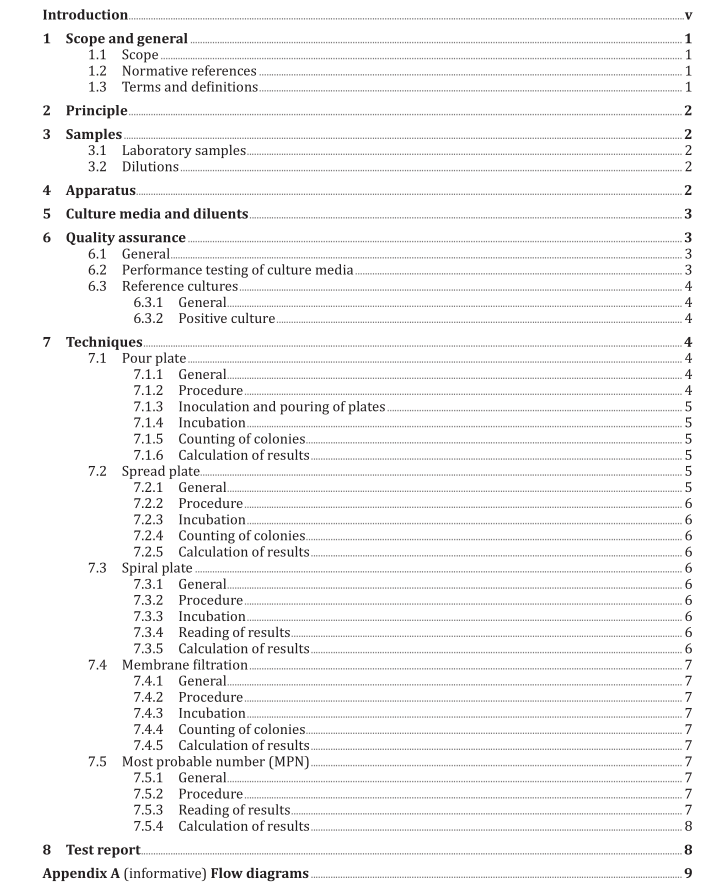AS 4276.3 pdf download – Water microbiology Method 3: Enumeration of heterotrophic microorganisms — Pour plate, spread plate, membrane filtration and most probable number techniques

AS 4276.3 pdf download – Water microbiology Method 3: Enumeration of heterotrophic microorganisms — Pour plate, spread plate, membrane filtration and most probable number techniques
During the preparation of the pour plates the following precautions shall be taken:(a)
Keep the lids of the plates in place except when they are partially lifted for adding theinoculum and the medium.
(b]
Do not exceed a time interval of 10 min between pipetting into the plate andpouring the medium.
(c)
Do not exceed a total time interval of 20 min between the preparation of the first dilution andthe pouring of the last plate.
7.1.3 Inoculation and pouring of platesPlates shall be inoculated and poured as follows:(a)
Prepare plates by adding 1 mL of sample or appropriate dilution to each plate.When dilution is necessary, plate out appropriate dilutions.
(b)
To each plate add molten agar,which has been cooled to 44 C to 46 °C, to a depth of3 mm to 5 mm.
NOTE Some organisms may suffer heat-shock above 47°C.
c)
lmmediately after pouring,keep the plate horizontal and, taking care not to wet the lid,thoroughly mix the medium and the inoculum by to-and-fro movements, followed by circularclockwise movements,followed by to-and-fro movements at right-angles to the first set,followed by circular anti-clockwise movements.
(d)
Allow the plates to stand on a horizontal surface until the medium has set.
7.1.4Incubation
lncubation shall be carried out as described in AS 4276.1.The plates should be incubated at 36°℃±2°Cfor 44±4 h and/or 22C±2C for 68±4 h, as required.
For cooling tower waters,the incubation used shall be 36 C±2°C for 44 ± 4 h.7.1.5Counting of colonies
The total number of colonies shall be counted as follows:(a
Register the count.
NOTE Use of a counter is recommended. If manually counting it is recommended to mark the countedcolonies to avoid recounting.Use of an illuminated magnification source can also assistin counting.
(b]
Count each spreading colony as a single colony.
Plates shall be rejected where 25 % or more of the medium is occupied by spreading organisms.7.1.6 Calculation of results
The calculation of results shall be carried out in accordance with AS 4276.1.7.2Spread plate
7.2.1 General
Surface spread plating is an alternative technique for enumerating microorganisms in water samples.This technique avoids heat shock and all colonies are on the agar surface where they can be readily
distinguished from particles and bubbles. Spread plates allow for easily discernible colonies to besub-cultured.
The major disadvantage of the spread plate technique is that the lower level of detection is increaseddue to the reduction in the volume of the inoculum able to be applied to the surface of the plate.
NOTEAflow diagram of the procedure is shown in Figure A.2.
7.2.2 Procedure
This procedure describes the technique for enumerating microorganisms in water by inoculating avolume of sample onto the surface of an agar plate.Record the volume of sample inoculated,
The procedure for spread plating shall be in accordance with AS 4276.1.
7.2.3 Incubation
Plates should be incubated at 36 °C± 2°C for 44 h ± 4 h and/or 22 °C± 2 °Cfor 68 h ± 4 h,as required.
7.2.4Counting of colonies
Colonies shall be counted and recorded after the incubation period.7.2.5Calculation of results
The calculation of results shall be carried out in accordance with AS 4276.1.
7.3Spiral plate
7.3.1General
This is a variation of the spread plate technique.
The spiral plater dispenses a known volume of the sample on the surface of a rotating agar plate inan Archimedes spiral. The volume of sample deposited is decreased as the dispensing stylus movesfrom the centre to the edge of the plate, so that an exponential relationship exists between the volumedeposited and the radius of the spiral. Following incubation, microorganisms present will develop onthe surface of the agar. Using a counting grid, the number of colonies in a known area is calculated byreferring to manufacturer’s instructions.
NOTE A flow diagram of the procedure is shown in Figure A.2.
7.3.2 Procedure
The procedure shall be in accordance with the manufacturer’s instructions.
7.3.3 Incubation
Plates should be incubated at 36C±2 °C for 44 h± 4 h and/or 22°C± 2°C for 68 h ± 4 h, as required.7.3.4 Reading of results
After the required incubation period, the reading of results shall be in accordance with themanufacturer’s instructions.
7.3.5 Calculation of results
The calculation of results shall be performed using the manufacturer’s instructions.









